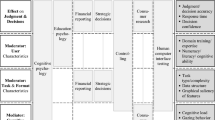Abstract
Many complex issues require a team of decision-makers to interact in a cohesive fashion. However, conventional committee meetings, lacking a structured approach to decision-making, are not best suited to making decisions about highly complex, multiobjective problems. Executive managers find that over 60% of their time is consumed by routine meetings arranged to coordinate the activities of subordinates or other interested parties. Many say they find this to be an expensive use of their time when they compare the time consumed against the results achieved. Interactive management (IM) brings a new efficiency to this problem. It both reduces the need for repetitive meetings to handle the same issue and increases the effectiveness of those meetings that still have to be held.
Similar content being viewed by others
Additional information
*Ken Hammer, who also works in the Interactive Management Unit, is a retired airline Operations Manager now researching IM applications at the Department of Systems Science.
**Ross Janes is Director of the Interactive Management Unit, Department of Systems Science, City University, London and Senior Lecturer in Systems Management. He studied and worked with John Warfield in Virginia and has six years' experience in practical application of IM in Britain.
Rights and permissions
About this article
Cite this article
Hammer, K., Janes, R. Interactive management. OR Insight 3, 11–13 (1990). https://doi.org/10.1057/ori.1990.4
Published:
Issue Date:
DOI: https://doi.org/10.1057/ori.1990.4




